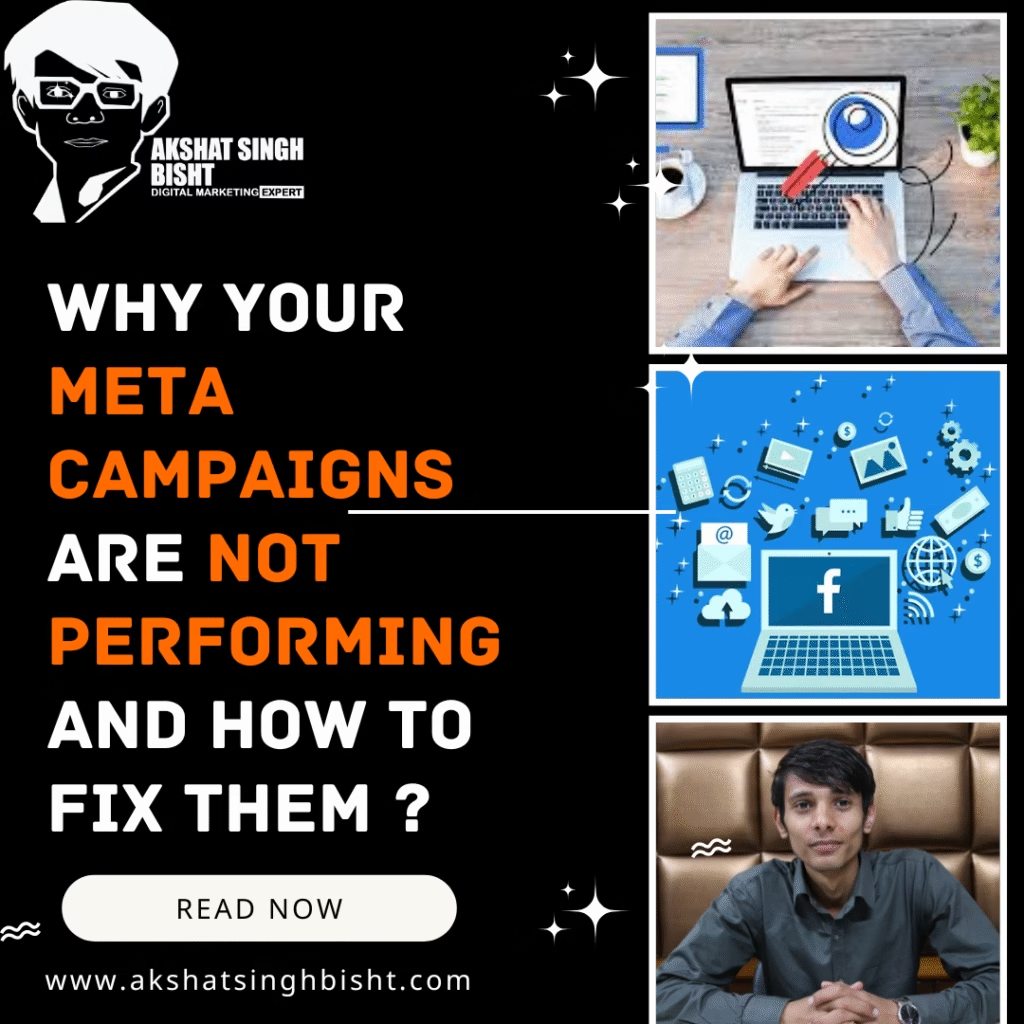Meta, which includes Facebook, Instagram, Messenger, and other platforms, boasts nearly 4 billion monthly active users globally. With such immense reach and sophisticated targeting capabilities, Meta Ads should be a marketer’s paradise. However, many businesses—big and small—struggle with poor results, high ad costs, and campaigns that fail to deliver.
So, why are your Meta campaigns underperforming? Is it the platform’s fault—or is something wrong with your strategy?
In this blog, we’ll uncover the major reasons why your Meta campaigns might be failing, backed by real data, industry research, and practical solutions you can implement immediately.

One of the most common causes of underperformance in Meta campaigns is incorrect or overly broad audience targeting. Many advertisers assume that selecting a few interests or age brackets is sufficient. In reality, the precision of your audience directly impacts your ROI.
According to a 2023 Hootsuite study, over 53% of failed Meta campaigns had poorly defined audience segments. When you target the wrong people, even the best creatives and offers will fall flat.
Solution:
Meta’s algorithm optimizes your campaign delivery based on the objective you choose. If you’re aiming for sales but select “Engagement” as your campaign goal, the algorithm will serve your ad to users more likely to like, share, or comment—not purchase.
This misalignment often leads to misleading vanity metrics and low conversion rates. Meta’s internal case studies indicate that conversion-focused campaigns generate up to 3x more purchases compared to traffic or engagement campaigns in the same budget bracket.
Solution:
Ad fatigue, generic stock photos, and uninspiring visuals are all major culprits behind poor campaign performance. Users scroll past over 300 feet of content daily—if your creative doesn’t stand out within the first two seconds, it’s ignored.
Meta’s research shows that ads featuring video or motion perform 73% better in CTR than static image ads. Furthermore, personalized creatives outperform generic brand messages by a wide margin.
Solution:
Even if your targeting and creatives are on point, a weak value proposition can ruin your chances of conversion. Many advertisers make the mistake of focusing on product features instead of benefits or fail to create a sense of urgency and relevance.
In a study by Wordstream, ads with compelling offers were found to generate 202% higher conversion rates than those with generic CTAs like “Shop Now” or “Learn More.”
Solution:
You may be running the perfect ad, but if the user clicks and lands on a slow, cluttered, or untrustworthy page, they’ll bounce. In fact, 53% of users will abandon a site if it takes longer than 3 seconds to load.
Moreover, if your landing page does not match the message of the ad, or if it’s hard to navigate, you’re wasting your ad spend.
Solution:
Running ads with too little budget in competitive markets—or overspending on unproven creatives—is a common issue. Additionally, failing to allocate budget appropriately across the funnel stages leads to inefficiencies and poor scaling.
Meta’s algorithm needs at least 50 conversion events per week per ad set to optimize effectively. Many small-budget campaigns never exit the learning phase, making them unstable and unpredictable.
Solution:
One of the most costly mistakes in Meta advertising is launching a campaign and leaving it untouched. Without continuous testing and optimization, you miss out on discovering high-performing combinations of creatives, audiences, and placements.
Top-performing advertisers typically run 3–5 structured A/B tests per month, refining campaigns based on measurable KPIs.
Solution:
A cluttered Ads Manager with mixed audience types, inconsistent naming, and overlapping interests can result in poor optimization and reporting. Meta’s delivery system performs better when structure is clean and logical.
Poor structure confuses the algorithm and leads to cannibalized results due to audience overlap and skewed data.
Solution:
Many brands invest heavily in cold outreach while completely ignoring warm audiences—people who already visited their site, engaged with content, or added products to the cart. These are your most qualified leads.
Retargeting campaigns typically deliver 10x–20x higher ROAS than cold campaigns because they target users already familiar with your brand.
Solution:
Conclusion: Winning on Meta Requires Strategy, Not Luck
Meta Ads can be one of the most powerful digital marketing tools—when used correctly. Poor campaign performance is often not due to the platform itself, but due to strategic misalignment, lack of testing, or weak creatives.
By identifying and fixing the above issues, you’ll be better positioned to lower your ad costs, improve conversion rates, and scale your campaigns with confidence.
Remember: Meta rewards data-driven advertisers who understand the platform’s mechanics and commit to constant optimization.
Need help auditing or optimizing your Meta campaigns?
Get in touch with our performance marketing team for a custom strategy that actually delivers results.
Akshat’s passion for marketing and dedication to helping others has been the driving force behind AkshatSinghBisht.com. Known for his insightful perspectives, practical advice, and unwavering commitment to his audience, Akshat is a trusted voice in the marketing community.
If you have any questions simply use the following contact details.
Welcome ! Let me know how I can assist you today.


